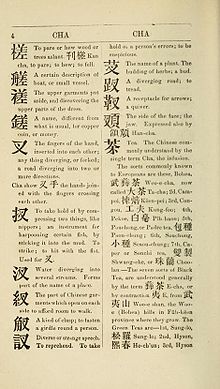Chinese dictionary
The Cangjiepian ("Chapters of Cang Jie"), named after the legendary inventor of writing, was edited by Li Si, and helped to standardize the Small seal script during the Qin dynasty.[3] Nevertheless, the Chinese made their dictionaries, and developed three original systems for lexicographical ordering: semantic categories, graphic components, and pronunciations.The circa 3rd-century BCE Erya ("Approaching Correctness") is the oldest extant Chinese dictionary, and scholarship reveals that it is a pre-Qin compilation of glosses to classical texts.The circa 1080 CE Piya ("Increased Erya"), from the Song dynasty, has 8 semantically based chapters of names for plants and animals.The 1615 CE Zihui ("Character Glossary"), edited by Mei Yingzuo [zh] during the Ming dynasty, simplified the 540 Shuowen Jiezi radicals to 214.As most Chinese characters are semantic-phonetic ones (形聲字), the radical method is usually effective, thus it continues to be widely used in the present day.A great number of modern dictionaries published today arrange their entries by pinyin or other methods of romanisation, together with a radicals index.In the traditional bibliographic divisions of the imperial collection Complete Library of the Four Treasuries , dictionaries were classified as belonging to xiǎoxué (小學, lit.Xiaoxue was divided into texts dealing with xùngǔ (訓詁, "exegesis" similar to "philology"), wénzì (文字, "script", analogous to "grammatology"), and yīnyùn (音韻, "sounds and rhymes," comparable to "phonology").While the above traditional pre-20th-century Chinese dictionaries focused upon the meanings and pronunciations of words in classical texts, they practically ignored the spoken language and vernacular literature.The foreigners who entered China in late Ming and Qing dynasties needed dictionaries for different purposes than native speakers.The linguist and professor of Chinese John DeFrancis edited the ABC Chinese–English Dictionary (1996), giving more than 196,000 words or terms alphabetically arranged in a single-tier pinyin order.[22] Shu Xincheng's (1936) Cihai ("Sea of Words") was a comprehensive dictionary of characters and expressions, and provided near-encyclopedic coverage in fields like science, philosophy, history.Wei Jiangong's (1953) Xinhua Zidian ("New China Character Dictionary") is a pocket-sized reference, alphabetically arranged by pinyin.[29] In recent years, the computerization of Chinese has allowed lexicographers to create dianzi cidian (電子詞典/电子词典 "electronic dictionaries") usable on computers, PDAs, etc.After Paul Denisowski started the volunteer CEDICT (Chinese–English dictionary) project in 1997, it has grown into a standard reference database.Some modern dictionaries for idioms are: The Chinese language adopted a few foreign wailaici (外來詞/外来词 "loanwords") during the Han dynasty, especially after Zhang Qian's exploration of the Western Regions.The lexicon absorbed many Buddhist terms and concepts when Chinese Buddhism began to flourish in the Southern and Northern dynasties.During the late 19th century, when Western powers forced open China's doors, numerous loanwords entered Chinese, many through the Japanese language.The 20th century saw the rapid progress of the studies of the lexicons found in the Chinese vernacular literature, which includes novels, dramas and poetry.These specialized Chinese dictionaries are available either as add-ons to existing publications like Yuan's 2004 Pocket Dictionary[32] and Wenlin or as specific ones like Victor H. Mair lists eight adverse features of traditional Chinese lexicography, some of which have continued up to the present day: (1) persistent confusion of spoken word with written graph; (2) lack of etymological science as opposed to the analysis of script; (3) absence of the concept of word; (4) ignoring the script's historical developments in the oracle bones and bronze inscriptions; (5) no precise, unambiguous, and convenient means for specifying pronunciations; (6) no standardized, user-friendly means for looking up words and graphs; (7) failure to distinguish linguistically between vernacular and literary registers, or between usages peculiar to different regions and times; and (8) open-endedness of the writing system, with current unabridged character dictionaries containing 60,000 to 85,000 graphs.

Yiqiejing yinyiBuddhist technical terminologyDunhuang manuscriptsdictionariesChinese languageChinese characterswritten Chinesea number of methods to order and sort charactersHan dynastylexicographicalMandarin ChineseFangyanvarieties of ChineseKangxi DictionaryQing dynastyKangxi radicalscharacter dictionariesChinesepinyinWade–GilesChinese classic textsShizhoupianKing Xuan of ZhouShuowen JieziCangjiepianCang JieSmall seal scriptQin dynastycollationlexicographical orderingwriting systemalphabetsyllabarySamuel Johnsonhis dictionarycharacterslogographJames BoswellXiao EryaGuangyaNorthern WeiSong dynastyShimingradicalsYupianLiang dynastyMei YingzuoMing dynastystrokesZhengzitongKangxi Emperor214 radicalssyllable rimerime dictionaryQieyunSui dynastyMiddle ChineseGuangyunfour corner encodingcangjie encodingLongkan ShoujianLiao dynastyComplete Library of the Four Treasuries linguisticsphilologygrammatologyphonologyorthographyGanlu Zishuscriptclerical scriptMorrison's Chinese dictionarylearn ChineseRobert MorrisonA Dictionary of the Chinese LanguageWalter Henry MedhurstMin NanChinese and English DictionaryaspiratedSamuel Wells WilliamsA Syllabic Dictionary of the Chinese LanguageBeijing pronunciationHerbert GilesA Chinese-English DictionaryCantoneseFuzhou dialectThomas Francis WadeWade-GilesRobert Henry MathewsMathews' Chinese-English Dictionarystructural linguisticsYuen Ren ChaoLien-sheng YangConcise Dictionary of Spoken ChineseGwoyeu Romatzyhfree morphemesbound morphemesBernhard KarlgrenGrammata Serica RecensaOld ChineseLin YutangLin Yutang's Chinese-English Dictionary of Modern UsageLiang Shih-ChiuJohn DeFrancisABC Chinese–English DictionaryVictor H. MairRepublic of ChinaZhonghua Da ZidianCiyuanZhuyin FuhaoXinhua Zidianreference workLü ShuxiangXiandai Hanyu CidianHanyu Da CidianHanyu Da ZidianWenlin Software for learning ChineseCEDICTUnihan Databasespecialized dictionaryoracle bone scriptSimplified ChineseTraditional ChineseWang LidialectEnglish dialects